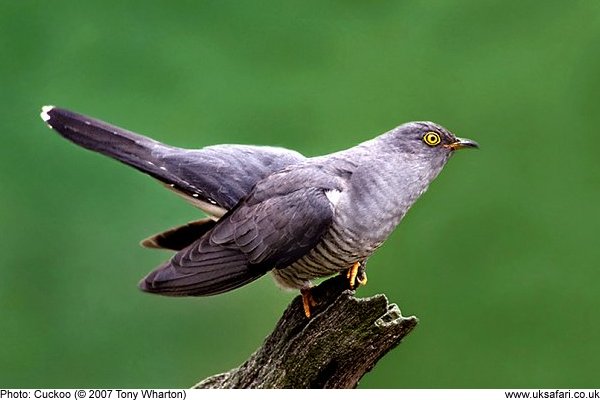 Quick Facts
Quick Facts
Scientific name: Cuculus canorus
Size: Approx 30cm
Distribution: Can be found throughout the UK, although in recent years numbers have been declining
Months seen: April to September. Cuckoos spend the winter months in Africa
Life Span: Average 1 year, but can live more than 8 years (source BTO)
Habitat: Parks, gardens and woodland
Food: Invertebrates
Special features: Cuckoo are birds which are more frequently heard than seen. Their call in April is a familiar springtime sound.
Listen to the call of a cuckoo (MP3 89KB)
The cuckoo is well known for it's parasitic nesting behavior. The female selects a suitable nest, usually made by a smaller bird. She removes one egg from the nest and lays one of her own in its place.
When the cuckoo chick hatches out, it pushes out the remaining eggs or chicks from the nest, ensuring full attention from its foster parents.
The foster parents feed the cuckoo chick as if it were their own, even after the chick has grown much larger than the parent bird.
Adult cuckoos migrate to Africa in July or August, and their offspring usually follow in September.
 Related Pages
Related Pages

 Popular Pages
Popular Pages
Amphibians, Bats, Badgers, Beetles, Birds, Birds of Prey, Bumble Bees, Butterflies, Caterpillars, Creepy-Crawlies, Deadly Spiders, Dolphins, Dragonflies, E-Postcards, False Widow Spiders, Free Newsletter, Frogs, Fungi, Garden Spiders, Glow-Worms, Grey Squirrels, Hedgehogs, House Spiders, Ladybirds, Mammals, Marine Mammals, Moths, Owls, Reptiles, Spiders, Toads, Trees, Wildlife Hospitals
Copyright © 2020 G. Bradley UK Safari. All rights reserved | About Us | Links | Contributors


 Cuckoos
Cuckoos


